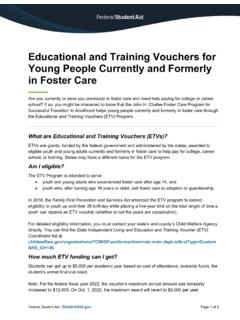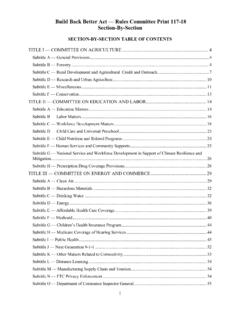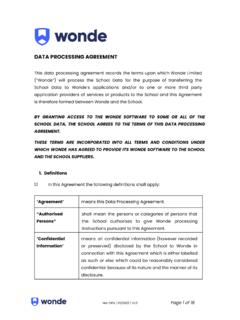Transcription of How are countries supporting tourism recovery?
1 1 How are countries supportingtourism recovery ?UNWTO BRIEFING NOTE tourism AND COVID-19, ISSUE 2 JUNE 20202 Table of ContentKey ConclusionsIntroductionCountries policy responseOverview of policy responsesKey considerations moving forward34517253 Key conclusions Governments have responded quickly and strongly with the level and coverage of measures steeping up over time. Most countries have adopted economy-wide stimulus packages (fiscal and monetary measures) along with job support measures. Across all regions, most measures currently in place aim at: i) providing fiscal relief and financial support to SMEs and self-employed workers (prevent bankruptcy, ensure survival and address liquidity shortage) and ii) promote the job retention and secure employment.
2 Due to its labor-intensive nature, and as one of the hardest-hit sectors, tourism is at the center of such policies. As the situation evolves and recognizing the need to implement tourism specific measures, countries have begun to deploy measures targeting directly tourism , particularly in those countries where the sector plays a significant role in the national economy, not only contributing to GDP but also to millions of jobs. During any crisis, governance is key and in some countries public-private partnership models have been reinforced and the role of committees and task forces enhanced with participation of stakeholders across different levels of administration and private sector.
3 Alongside these measures, since mid-May a growing number of countries have announced measures to restart tourism , particularly safety protocols, and to promote domestic tourism . 4 Introduction1. World tourism Organization (UNWTO), UNWTO World tourism Barometer, Issue 18, May 2020. 2. More information on UNWTO monitoring of Travel Restrictions. 3. This briefing note is based on information available at the UNWTO online interactive dashboard of Covid-19: measures to support travel and tourism as of May 22, an unprecedented crisis to the tourism sector, the COVID-19 pandemic is having a major impact across world regions.
4 Available data shows that international tourist arrivals have sharply decreased in the first quarter of 2020 (-22%), with possible scenarios for the year pointing to an annual decline of between 60% and 80% when compared with 2019 figures depending on the pace of easing travel The outbreak of COVID-19 has impacted countries at different times, in different ways and in varying degrees. Yet, around the world, response to curb the pandemic has translated into national lockdowns and a wide implementation of travel restrictions and shutdown of borders2 making tourism one of the hardest-hit extensive and deep impact of COVID-19 on tourism coupled with the relevance of the sector to the economy and jobs requires a strong support at national and international level through the relevant on information from governments, international organizations and online official public sources.
5 UNWTO has launched an online interactive dashboard on country and international policy responses to COVID-19 covering 220 countries and territories and more than 30 international and regional This briefing note offers an overview and analysis of the main measures adopted by countries to mitigate the effects of COVID-19 in tourism and support policyresponseA closer look at the measures adopted across all regions shows that there has been a swift and strong response by governments around the world to the impacts of COVID-19. Along with health and confinement measures as well as travel restrictions, countries have adopted a wide range of economic and social measures to respond to the crisis - in many cases supported by international and regional , the immediate and first response from governments consisted of cross-cutting fiscal and monetary measures to mitigate the economic impact of the crisis, with a special focus on SMEs liquidity, and protect jobs in the most severely affected sectors.
6 As the situation evolves, countries increasingly adopted tourism specific measures as well as measures to reopen and restart the sector. This is particularly noticeable for countries in which tourism is a significant contributor to the national economy. By far the most common measures adopted by countries are economy-wide stimulus packages targeting the most impacted sectors. Of these, undeniably tourism is one of the most directly affected. Fiscal stimulus packages most commonly in place refer to exemptions or deferrals of VAT and corporate income tax, emergency economic funds and economic assistance, especially to SMEs and self-employed and investment programmes aiming at mitigating the immediate effects of the , the European Commission and other regional and international institutions such as the International Monetary Fund (IMF), the World Bank, regional development banks and other International Finance Institutions (IFIs)
7 4 and other organizations such as United Nations agencies and the Organization for Economic Co-operation and Development Across all regions there has been a strong and widespread policy response to the impact of COVID-19 pandemic. Out of the 220 countries and territories analyzed, 167 countries have reported specific measures to mitigate the effects of the crisis and accelerate recovery . Among them, more than 144 countries have adopted fiscal and monetary policies, followed by policies to support jobs and training which have been implemented by 100 countries .
8 Fiscal and monetary policies are also the most popular in all regions. The most recent measures for restarting tourism are primarily being adopted in Europe and Asia and the of main policies (% of countries , n=167)Overall strong and widespread policy response across regionsJobs and Training7(OECD), have largely supported countries , especially with programmes for SMEs, self-employed and job protection through different mechanisms: special funds and loans, financial tools, technical assistance, recommendations, for monetary policies, these generally include the creation of special credit lines at reduced, subsidized or zero rates, moratoria on loans and the introduction of measures to facilitate access to credit and finance, and less frequently, measures to ensure the stability of national currency and consumer prices.
9 As in the case of fiscal measures, all these programmes aim to provide financial support to businesses and address liquidity shortage. In Africa predominantly, but also in some countries in other regions, governments have also received economic assistance in the form of loans, grants, special lines of credits, from international organizations, international financial institutions, such as the IMF, the World Bank, the European Commission and regional development banks. As per fiscal and monetary measures supporting tourism directly these range from economic relief to tourism businesses, especially SMEs, such as the exemption or postponement of taxes, loan payments, and tourism related fees, to the introduction of financial instruments such as special lines of credit, new loan schemes, and investment programmes.
10 Other tourism specific measures include credit guarantees for tourism businesses and incentive programmes to support Such as the African Development Bank (AfDB), the Asian Development Bank (ADB), the Central American Bank for Economic Integration (CABEI), the Development Bank of Latin America (CAF), the European Bank for Reconstruction and Development (EBRD), the European Investment Bank (EIB), the Inter-American Development Bank (IADB), the Multilateral Investment Guarantee Agency (MIGA).Jobs and Training policiesRestarting tourism policiesFiscal and Monetary policies% of countries adopting policies per region (n=167)8 The fiscal and monetary policies are complemented with a third pillar to protect the millions of jobs at risk through specific packages to sustain jobs, income and livelihoods.









